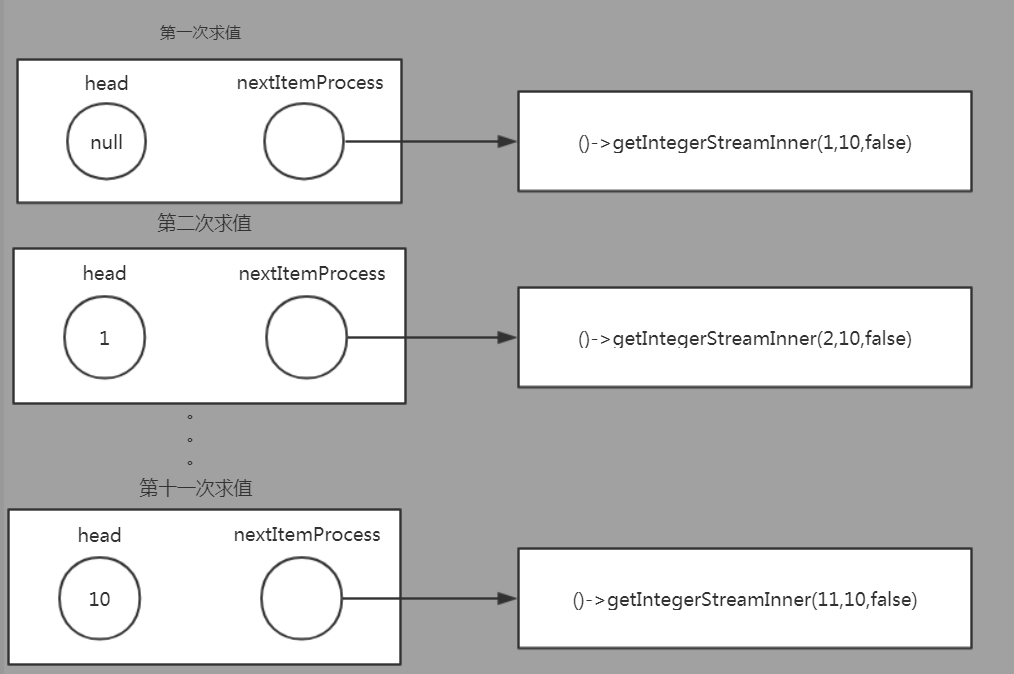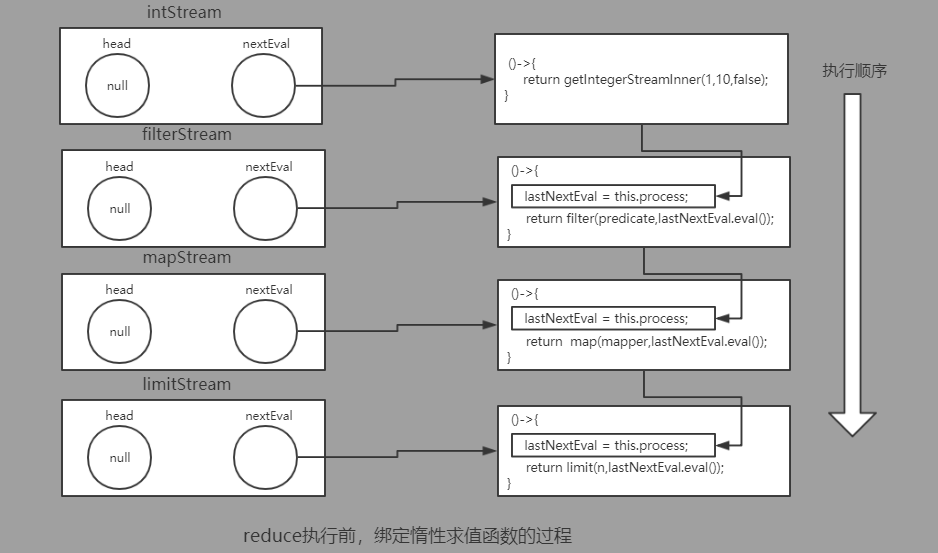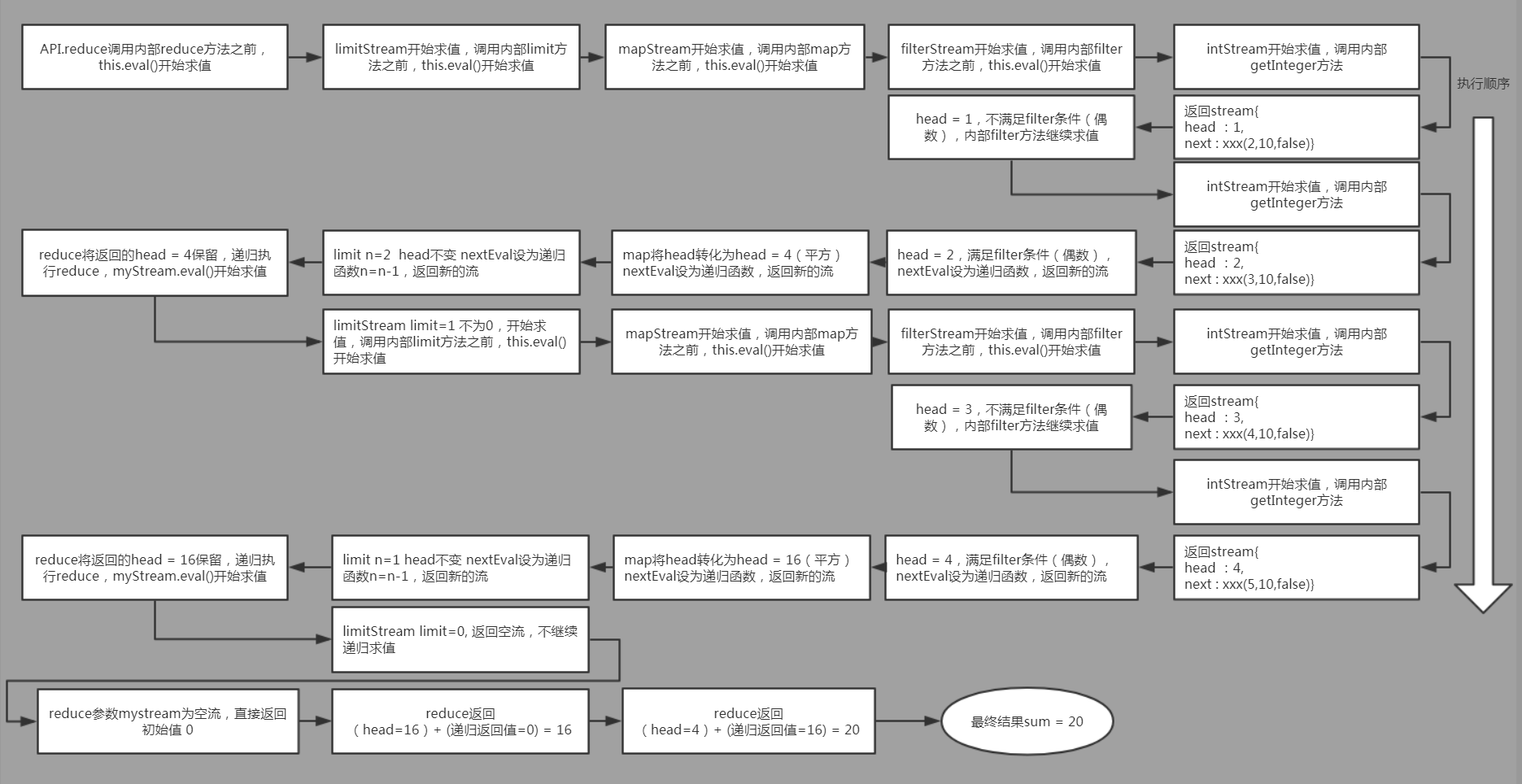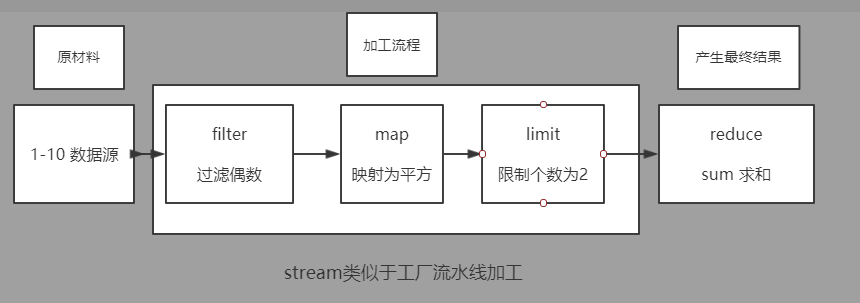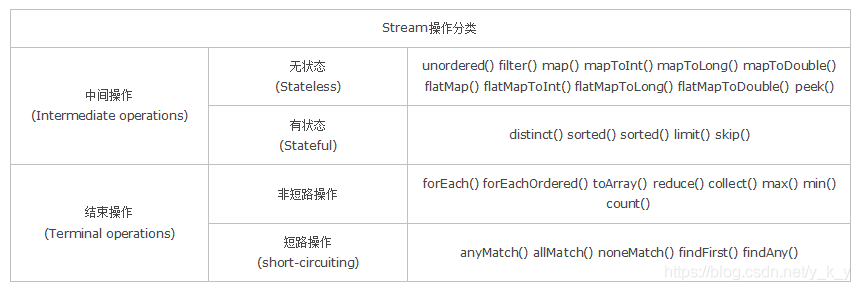# Stream 流的介绍
# 1.1 java8 stream 介绍
java8 新增了 stream 流的特性,能够让用户以函数式的方式、更为简单的操纵集合等数据结构,并实现了用户无感知的并行计算。
# 1.2 从零开始实现一个 stream 流
相信很多人在使用过 java8 的 streamAPI 接口之后,都会对其实现原理感到好奇,但往往在看到 jdk 的 stream 源码后却被其复杂的抽象、封装给弄糊涂了,而无法很好的理解其背后的原理。究其原因,是因为 jdk 的 stream 源码是高度工程化的代码,工程化的代码为了效率和满足各式各样的需求,会将代码实现的极其复杂,不易理解。
在这里,我们将抛开 jdk 的实现思路,从零开始实现一个 stream 流。
我们的 stream 流同样拥有惰性求值,函数式编程接口等特性,并兼容 jdk 的 Collection 等数据结构 (但不支持并行计算 orz )。
相信在亲手实现一个 stream 流的框架之后,大家能更好的理解流计算的原理。
# stream 的优点
在探讨探究 stream 的实现原理和动手实现之前,我们先要体会 stream 流计算的独特之处。
举个例子: 有一个 List<Person> 列表,我们需要获得年龄为 70 岁的前 10 个 Person 的姓名。
过程式的解决方案:
稍加思考,我们很快就写出了一个过程式的解决方案 (伪代码):
1
2
3
4
5
6
7
8
9
10
11
12
| List<Person> personList = fromDB();
int limit = 10;
List<String> nameList = new ArrayList();
for(Person personItem : personList){
if(personItem.age == 70){
nameList.add(personItem.name);
if(nameList.size() >= 10){
break;
}
}
}
return nameList;
|
函数式 stream 解决方案:
下面我们给出一种基于 stream 流的解决方案 (伪代码):
1
2
3
4
5
6
7
8
| List<Person> personList = fromDB();
List<String> nameList = personList.stream()
.filter(item->item.age == 70)
.limit(10)
.map(item->item.name)
.collect(Collector.toList());
return nameList;
|
两种方案的不同之处:
从函数式的角度上看,过程式的代码实现将收集元素、循环迭代、各种逻辑判断耦合在一起,暴露了太多细节。当未来需求变动和变得更加复杂的情况下,过程式的代码将变得难以理解和维护 (需要控制台打印出 年龄为 70 岁的前 10 个 Person 中,姓王的 Person 的名称)。
函数式的解决方案解开了代码细节和业务逻辑的耦合,类似于 sql 语句,表达的是 "要做什么" 而不是 "如何去做",使程序员可以更加专注于业务逻辑,写出易于理解和维护的代码。
1
2
3
4
5
6
7
| List<Person> personList = fromDB();
personList.stream()
.filter(item->item.age == 70)
.limit(10)
.filter(item->item.name.startWith("王"))
.map(item->item.name)
.forEach(System.out::println);
|
# stream API 接口介绍
stream API 的接口是函数式的,尽管 java 8 也引入了 lambda 表达式,但 java 实质上依然是由接口 - 匿名内部类来实现函数传参的,所以需要事先定义一系列的函数式接口。
Function: 类似于 y = F(x)
1
2
3
4
5
6
7
8
9
| @FunctionalInterface
public interface Function<R,T> {
R apply(T t);
}
|
BiFunction : 类似于 z = F(x,y)
1
2
3
4
5
6
7
8
9
| @FunctionalInterface
public interface BiFunction<R, T, U> {
R apply(T t, U u);
}
|
ForEach : 遍历处理
1
2
3
4
5
6
7
8
9
| @FunctionalInterface
public interface ForEach <T>{
void apply(T item);
}
|
Comparator : 比较器
1
2
3
4
5
6
7
8
9
10
11
12
13
| @FunctionalInterface
public interface Comparator<T> {
int compare(T o1, T o2);
}
|
Predicate: 条件判断
1
2
3
4
5
6
7
8
9
10
11
| @FunctionalInterface
public interface Predicate <T>{
boolean satisfy(T item);
}
|
Supplier: 提供初始值
1
2
3
4
5
6
7
8
9
| @FunctionalInterface
public interface Supplier<T> {
T get();
}
|
EvalFunction:stream 求值函数
1
2
3
4
5
6
7
8
9
| @FunctionalInterface
public interface EvalFunction<T> {
MyStream<T> apply();
}
|
# stream API 接口:
1
2
3
4
5
6
7
8
9
10
11
12
13
14
15
16
17
18
19
20
21
22
23
24
25
26
27
28
29
30
31
32
33
34
35
36
37
38
39
40
41
42
43
44
45
46
47
48
49
50
51
52
53
54
55
56
57
58
59
60
61
62
63
64
65
66
67
68
69
70
71
72
73
74
75
76
77
78
79
80
81
82
83
84
85
86
87
88
89
90
91
92
93
94
95
96
97
98
99
100
101
102
103
104
105
106
107
108
109
|
public interface Stream<T> {
<R> MyStream<R> map(Function<R,T> mapper);
<R> MyStream<R> flatMap(Function<? extends MyStream<R>, T> mapper);
MyStream<T> filter(Predicate<T> predicate);
MyStream<T> limit(int n);
MyStream<T> distinct();
MyStream<T> peek(ForEach<T> consumer);
void forEach(ForEach<T> consumer);
<R> R reduce(R initVal, BiFunction<R, R, T> accumulator);
<R, A> R collect(Collector<T,A,R> collector);
T max(Comparator<T> comparator);
T min(Comparator<T> comparator);
int count();
boolean anyMatch(Predicate<? super T> predicate);
boolean allMatch(Predicate<? super T> predicate);
static <T> MyStream<T> makeEmptyStream(){
return new MyStream.Builder<T>().isEnd(true).build();
}
}
|
# MyStream 实现细节
简单介绍了 API 接口定义之后,我们开始深入探讨流的内部实现。
流由两个重要的部分所组成,当前数据项 (head)"和" 下一数据项的求值函数 (nextItemEvalProcess) 。
其中, nextItemEvalProcess 是流能够实现 "惰性求值" 的关键。
![]()
流的基本属性:
1
2
3
4
5
6
7
8
9
10
11
12
13
14
15
16
17
18
19
20
21
22
23
24
25
26
27
28
29
30
31
32
33
34
35
36
37
38
39
40
41
42
43
44
45
46
47
48
49
50
51
52
53
54
55
56
57
58
| public class MyStream<T> implements Stream<T> {
private T head;
private NextItemEvalProcess nextItemEvalProcess;
private boolean isEnd;
public static class Builder<T>{
private MyStream<T> target;
public Builder() {
this.target = new MyStream<>();
}
public Builder<T> head(T head){
target.head = head;
return this;
}
Builder<T> isEnd(boolean isEnd){
target.isEnd = isEnd;
return this;
}
public Builder<T> nextItemEvalProcess(NextItemEvalProcess nextItemEvalProcess){
target.nextItemEvalProcess = nextItemEvalProcess;
return this;
}
public MyStream<T> build(){
return target;
}
}
private MyStream<T> eval(){
return this.nextItemEvalProcess.eval();
}
private boolean isEmptyStream(){
return this.isEnd;
}
}
|
1
2
3
4
5
6
7
8
9
10
11
12
13
14
15
16
17
18
|
public class NextItemEvalProcess {
private EvalFunction evalFunction;
public NextItemEvalProcess(EvalFunction evalFunction) {
this.evalFunction = evalFunction;
}
MyStream eval(){
return evalFunction.apply();
}
}
|
# 4.1 stream 流在使用过程中的三个阶段
-
生成并构造一个流 (List.stream () 等方法)
-
在流的处理过程中添加、绑定惰性求值流程 (map、filter、limit 等方法)
-
对流使用强制求值函数,生成最终结果 (max、collect、forEach 等方法)
# 4.2 生成并构造一个流
流在生成时是 "纯净" 的,其最初的 NextItemEvalProcess 求值之后就是指向自己的下一个元素。
我们以一个 Integer 整数流的生成为例。 IntegerStreamGenerator.getIntegerStream(1,10) 会返回一个流结构,其逻辑上等价于一个从 1 到 10 的整数流。但实质是一个惰性求值的 stream 对象,这里称其为 IntStream ,其 NextItemEvalProcess 是一个闭包,方法体是一个递归结构的求值函数,其中下界参数 low = low + 1 。
当 IntStream 第一次被求值时,流开始初始化, isStart = false 。当初始化完成之后,每一次求值,都会生成一个新的流对象,其中 head(low) = low + 1 。当 low > high 时,流被终止,返回空的流对象。
![]()
1
2
3
4
5
6
7
8
9
10
11
12
13
14
15
16
17
18
19
20
21
22
23
24
25
26
27
28
29
30
31
32
33
34
35
|
public class IntegerStreamGenerator {
public static MyStream<Integer> getIntegerStream(int low, int high){
return getIntegerStreamInner(low,high,true);
}
private static MyStream<Integer> getIntegerStreamInner(int low, int high, boolean isStart){
if(low > high){
return Stream.makeEmptyStream();
}
if(isStart){
return new MyStream.Builder<Integer>()
.process(new NextItemEvalProcess(()->getIntegerStreamInner(low,high,false)))
.build();
}else{
return new MyStream.Builder<Integer>()
.head(low)
.process(new NextItemEvalProcess(()->getIntegerStreamInner(low+1,high,false)))
.build();
}
}
}
|
可以看到,生成一个流的关键在于确定如何求值下一项元素。对于整数流来说, low = low + 1 就是其下一项的求值过程。
那么对于我们非常关心的 jdk 集合容器,又该如何生成对应的流呢?
答案是 Iterator 迭代器, jdk 的集合容器都实现了 Iterator 迭代器接口,通过迭代器我们可以轻易的取得容器的下一项元素,而不用关心容器内部实现细节。换句话说,只要实现过迭代器接口,就可以自然的转化为 stream 流,从而获得流计算的所有能力。
1
2
3
4
5
6
7
8
9
10
11
12
13
14
15
16
17
18
19
20
21
22
23
24
25
26
27
28
29
30
31
32
33
34
35
36
|
public class CollectionStreamGenerator {
public static <T> MyStream<T> getListStream(List<T> list){
return getListStream(list.iterator(),true);
}
private static <T> MyStream<T> getListStream(Iterator<T> iterator, boolean isStart){
if(!iterator.hasNext()){
return Stream.makeEmptyStream();
}
if(isStart){
return new MyStream.Builder<T>()
.nextItemEvalProcess(new NextItemEvalProcess(()-> getListStream(iterator,false)))
.build();
}else{
return new MyStream.Builder<T>()
.head(iterator.next())
.nextItemEvalProcess(new NextItemEvalProcess(()-> getListStream(iterator,false)))
.build();
}
}
}
|
# 举例分析
我们选择一个简单而又不失一般性的例子,串联起这些内容。通过完整的描述一个流求值的全过程,加深大家对流的理解。
1
2
3
4
5
6
7
8
9
| public static void main(String[] args){
Integer sum = IntegerStreamGenerator.getIntegerStream(1,10)
.filter(item-> item%2 == 0)
.map(item-> item * item)
.limit(2)
.reduce(0,(i1,i2)-> i1+i2);
System.out.println(sum);
}
|
由于我们的 stream 实现采用的是链式编程的方式,不太好理解,将其展开为逻辑等价的形式。
1
2
3
4
5
6
7
8
9
10
11
12
13
| public static void main(String[] args){
Stream<Integer> intStream = IntegerStreamGenerator.getIntegerStream(1,10);
Stream<Integer> filterStream = intStream.filter(item-> item%2 == 0);
Stream<Integer> mapStream = filterStream.map(item-> item * item);
Stream<Integer> limitStream = mapStream.limit(2);
Integer sum = limitStream.reduce(0,(i1,i2)-> i1+i2);
System.out.println(sum);
}
|
reduce 强制求值操作之前的执行过程图:
![]()
reduce 强制求值过程中的执行过程图 :
![]()
可以看到, stream 的求值过程并不会一口气将初始的流全部求值,而是按需的、一个一个的进行求值。
stream 的一次求值过程至多只会遍历流中元素一次;如果存在短路操作 ( limit、anyMatch 等),实际迭代的次数会更少。
因此不必担心多层的 map、filter 处理逻辑的嵌套会让流进行多次迭代,导致效率急剧下降。
![]()
# 具体用法
![]()
# 1. 流的常用创建方法
# 1.1 使用 Collection 下的 stream() 和 parallelStream() 方法
1
2
3
| List<String> list = new ArrayList<>();
Stream<String> stream = list.stream();
Stream<String> parallelStream = list.parallelStream();
|
# 1.2 使用 Arrays 中的 stream() 方法,将数组转成流
1
2
| Integer[] nums = new Integer[10];
Stream<Integer> stream = Arrays.stream(nums);
|
# 1.3 使用 Stream 中的静态方法: of()、iterate()、generate()
1
2
3
4
5
6
7
| Stream<Integer> stream = Stream.of(1,2,3,4,5,6);
Stream<Integer> stream2 = Stream.iterate(0, (x) -> x + 2).limit(6);
stream2.forEach(System.out::println);
Stream<Double> stream3 = Stream.generate(Math::random).limit(2);
stream3.forEach(System.out::println);
|
# 1.4 使用 BufferedReader.lines() 方法,将每行内容转成流
1
2
3
| BufferedReader reader = new BufferedReader(new FileReader("F:\\test_stream.txt"));
Stream<String> lineStream = reader.lines();
lineStream.forEach(System.out::println);
|
# 1.5 使用 Pattern.splitAsStream() 方法,将字符串分隔成流
1
2
3
| Pattern pattern = Pattern.compile(",");
Stream<String> stringStream = pattern.splitAsStream("a,b,c,d");
stringStream.forEach(System.out::println);
|
# 2. 流的中间操作
# 2.1 筛选与切片
filter: 过滤流中的某些元素
limit(n): 获取 n 个元素
skip(n): 跳过 n 元素,配合 limit(n) 可实现分页
distinct: 通过流中元素的 hashCode() 和 equals() 去除重复元素
1
2
3
4
5
6
7
| Stream<Integer> stream = Stream.of(6, 4, 6, 7, 3, 9, 8, 10, 12, 14, 14);
Stream<Integer> newStream = stream.filter(s -> s > 5)
.distinct()
.skip(2)
.limit(2);
newStream.forEach(System.out::println);
|
# 2.2 映射
map: 接收一个函数作为参数,该函数会被应用到每个元素上,并将其映射成一个新的元素。flatMap: 接收一个函数作为参数,将流中的每个值都换成另一个流,然后把所有流连接成一个流。
1
2
3
4
5
6
7
8
9
10
11
12
13
| List<String> list = Arrays.asList("a,b,c", "1,2,3");
Stream<String> s1 = list.stream().map(s -> s.replaceAll(",", ""));
s1.forEach(System.out::println);
Stream<String> s3 = list.stream().flatMap(s -> {
String[] split = s.split(",");
Stream<String> s2 = Arrays.stream(split);
return s2;
});
s3.forEach(System.out::println);
|
# 2.3 排序
sorted(): 自然排序,流中元素需实现 Comparable 接口sorted(Comparator com): 定制排序,自定义 Comparator 排序器
1
2
3
4
5
6
7
8
9
10
11
12
13
14
15
16
17
18
19
20
| List<String> list = Arrays.asList("aa", "ff", "dd");
list.stream().sorted().forEach(System.out::println);
Student s1 = new Student("aa", 10);
Student s2 = new Student("bb", 20);
Student s3 = new Student("aa", 30);
Student s4 = new Student("dd", 40);
List<Student> studentList = Arrays.asList(s1, s2, s3, s4);
studentList.stream().sorted(
(o1, o2) -> {
if (o1.getName().equals(o2.getName())) {
return o1.getAge() - o2.getAge();
} else {
return o1.getName().compareTo(o2.getName());
}
}
).forEach(System.out::println);
|
# 2.4 消费
peek: 如同于 map ,能得到流中的每一个元素。但 map 接收的是一个 Function 表达式,有返回值;而 peek 接收的是 Consumer 表达式,没有返回值。
1
2
3
4
5
6
7
8
9
10
11
| Student s1 = new Student("aa", 10);
Student s2 = new Student("bb", 20);
List<Student> studentList = Arrays.asList(s1, s2);
studentList.stream()
.peek(o -> o.setAge(100))
.forEach(System.out::println);
Student{name='aa', age=100}
Student{name='bb', age=100}
|
# 3. 流的终止操作
# 3.1 匹配、聚合操作
allMatch :接收一个 Predicate 函数,当流中每个元素都符合该断言时才返回 true ,否则返回 false
noneMatch :接收一个 Predicate 函数,当流中每个元素都不符合该断言时才返回 true ,否则返回 falseanyMatch :接收一个 Predicate 函数,只要流中有一个元素满足该断言则返回 true ,否则返回 falsefindFirst :返回流中第一个元素findAny :返回流中的任意元素count :返回流中元素的总个数max :返回流中元素最大值min :返回流中元素最小值
1
2
3
4
5
6
7
8
9
10
11
12
| List<Integer> list = Arrays.asList(1, 2, 3, 4, 5);
boolean allMatch = list.stream().allMatch(e -> e > 10);
boolean noneMatch = list.stream().noneMatch(e -> e > 10);
boolean anyMatch = list.stream().anyMatch(e -> e > 4);
Integer findFirst = list.stream().findFirst().get();
Integer findAny = list.stream().findAny().get();
long count = list.stream().count();
Integer max = list.stream().max(Integer::compareTo).get();
Integer min = list.stream().min(Integer::compareTo).get();
|
# 3.2 规约操作
Optional<T> reduce(BinaryOperator<T> accumulator): 第一次执行时, accumulator 函数的第一个参数为流中的第一个元素,第二个参数为流中元素的第二个元素;第二次执行时,第一个参数为第一次函数执行的结果,第二个参数为流中的第三个元素;依次类推。
T reduce(T identity, BinaryOperator<T> accumulator): 流程跟上面一样,只是第一次执行时, accumulator 函数的第一个参数为 identity ,而第二个参数为流中的第一个元素。
<U> U reduce(U identity,BiFunction<U, ? super T, U> accumulator,BinaryOperator<U> combiner): 在串行流 ( stream ) 中,该方法跟第二个方法一样,即第三个参数 combiner 不会起作用。在并行流 ( parallelStream ) 中,我们知道流被 fork join 出多个线程进行执行,此时每个线程的执行流程就跟第二个方法 reduce(identity,accumulator) 一样,而第三个参数 combiner 函数,则是将每个线程的执行结果当成一个新的流,然后使用第一个方法 reduce(accumulator) 流程进行规约。
1
2
3
4
5
6
7
8
9
10
11
12
13
14
15
16
17
18
19
20
21
22
23
24
25
26
27
28
29
30
|
List<Integer> list = Arrays.asList(1, 2, 3, 4, 5, 6, 7, 8, 9, 10, 11, 12, 13, 14, 15, 16, 17, 18, 19, 20, 21, 22, 23, 24);
Integer v = list.stream().reduce((x1, x2) -> x1 + x2).get();
System.out.println(v);
Integer v1 = list.stream().reduce(10, (x1, x2) -> x1 + x2);
System.out.println(v1);
Integer v2 = list.stream().reduce(0,
(x1, x2) -> {
System.out.println("stream accumulator: x1:" + x1 + " x2:" + x2);
return x1 - x2;
},
(x1, x2) -> {
System.out.println("stream combiner: x1:" + x1 + " x2:" + x2);
return x1 * x2;
});
System.out.println(v2);
Integer v3 = list.parallelStream().reduce(0,
(x1, x2) -> {
System.out.println("parallelStream accumulator: x1:" + x1 + " x2:" + x2);
return x1 - x2;
},
(x1, x2) -> {
System.out.println("parallelStream combiner: x1:" + x1 + " x2:" + x2);
return x1 * x2;
});
System.out.println(v3);
|
# 3.3 收集操作
collect :接收一个 Collector 实例,将流中元素收集成另外一个数据结构。Collector<T, A, R> 是一个接口,有以下 5 个抽象方法:Supplier<A> supplier() :创建一个结果容器 ABiConsumer<A, T> accumulator() :消费型接口,第一个参数为容器 A,第二个参数为流中元素 T 。BinaryOperator<A> combiner() :函数接口,该参数的作用跟上一个方法 ( reduce ) 中的 combiner 参数一样,将并行流中各个子进程的运行结果 ( accumulator 函数操作后的容器 A ) 进行合并。Function<A, R> finisher() :函数式接口,参数为:容器 A ,返回类型为: collect 方法最终想要的结果 R 。Set<Characteristics> characteristics() :返回一个不可变的 Set 集合,用来表明该 Collector 的特征。有以下三个特征:
CONCURRENT :表示此收集器支持并发。(官方文档还有其他描述,暂时没去探索,故不作过多翻译)UNORDERED :表示该收集操作不会保留流中元素原有的顺序。IDENTITY_FINISH :表示 finisher 参数只是标识而已,可忽略。
# 3.3.1 Collector 工具库:Collectors
1
2
3
4
5
6
7
8
9
10
11
12
13
14
15
16
17
18
19
20
21
22
23
24
25
26
27
28
29
30
31
32
33
34
35
36
37
38
39
40
41
| Student s1 = new Student("aa", 10,1);
Student s2 = new Student("bb", 20,2);
Student s3 = new Student("cc", 10,3);
List<Student> list = Arrays.asList(s1, s2, s3);
List<Integer> ageList = list.stream().map(Student::getAge).collect(Collectors.toList());
Set<Integer> ageSet = list.stream().map(Student::getAge).collect(Collectors.toSet());
Map<String, Integer> studentMap = list.stream().collect(Collectors.toMap(Student::getName, Student::getAge));
String joinName = list.stream().map(Student::getName).collect(Collectors.joining(",", "(", ")"));
Long count = list.stream().collect(Collectors.counting());
Integer maxAge = list.stream().map(Student::getAge).collect(Collectors.maxBy(Integer::compare)).get();
Integer sumAge = list.stream().collect(Collectors.summingInt(Student::getAge));
Double averageAge = list.stream().collect(Collectors.averagingDouble(Student::getAge));
DoubleSummaryStatistics statistics = list.stream().collect(Collectors.summarizingDouble(Student::getAge));
System.out.println("count:" + statistics.getCount() + ",max:" + statistics.getMax() + ",sum:" + statistics.getSum() + ",average:" + statistics.getAverage());
Map<Integer, List<Student>> ageMap = list.stream().collect(Collectors.groupingBy(Student::getAge));
Map<Integer, Map<Integer, List<Student>>> typeAgeMap = list.stream().collect(Collectors.groupingBy(Student::getType, Collectors.groupingBy(Student::getAge)));
Map<Boolean, List<Student>> partMap = list.stream().collect(Collectors.partitioningBy(v -> v.getAge() > 10));
Integer allAge = list.stream().map(Student::getAge).collect(Collectors.reducing(Integer::sum)).get();
|
# 3.3.2 Collectors.toList() 解析
1
2
3
4
5
6
7
8
9
10
11
12
13
14
15
16
17
18
19
20
21
22
23
24
25
26
27
28
29
30
31
32
33
34
35
36
37
38
39
40
41
42
43
44
45
46
47
48
|
public static <T> Collector<T, ?, List<T>> toList() {
return new CollectorImpl<>((Supplier<List<T>>) ArrayList::new, List::add,
(left, right) -> {
left.addAll(right);
return left;
}, CH_ID);
}
public <T> Collector<T, ?, List<T>> toList() {
Supplier<List<T>> supplier = () -> new ArrayList();
BiConsumer<List<T>, T> accumulator = (list, t) -> list.add(t);
BinaryOperator<List<T>> combiner = (list1, list2) -> {
list1.addAll(list2);
return list1;
};
Function<List<T>, List<T>> finisher = (list) -> list;
Set<Collector.Characteristics> characteristics = Collections.unmodifiableSet(EnumSet.of(Collector.Characteristics.IDENTITY_FINISH));
return new Collector<T, List<T>, List<T>>() {
@Override
public Supplier supplier() {
return supplier;
}
@Override
public BiConsumer accumulator() {
return accumulator;
}
@Override
public BinaryOperator combiner() {
return combiner;
}
@Override
public Function finisher() {
return finisher;
}
@Override
public Set<Characteristics> characteristics() {
return characteristics;
}
};
}
|

